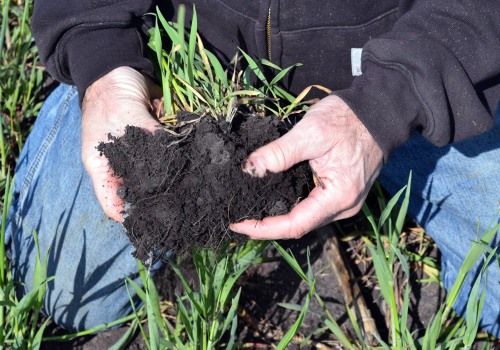Soil testing is an important tool for understanding the composition of the earth beneath us. By assessing and analyzing the micronutrients in the soil, we can gain insight into the health of the land and the potential for plants to thrive. In this article, we explore the benefits of using micronutrient test results for soils and the potential impact on agricultural production. The use of micronutrient tests can provide valuable information on soil fertility and how well different crops will grow in different conditions. By understanding these tests, farmers and gardeners can make more informed decisions about which fertilizers to use and how much to apply.
Additionally, these tests can help identify nutrient deficiencies that may need to be addressed. In addition to helping farmers and gardeners, micronutrient tests can also help environmental scientists understand how pollutants are affecting soil health. For example, some chemicals can damage micronutrients in the soil, leading to unhealthy plants and reduced crop yields. By analyzing the micronutrients in a soil sample, scientists can better understand how pollutants are impacting the environment. Finally, micronutrient testing can help researchers better understand how different crops respond to different soil conditions. By studying micronutrient levels in soils across different regions, researchers can gain insight into which crops work best in different areas and how to optimize soil fertility. In this article, we will explore the benefits of using micronutrient test results for soils and discuss how they can be used to improve agricultural production. Micronutrient tests are an important tool for assessing the levels of micronutrients in the soil.
They can provide valuable insights into soil health and help farmers to identify deficiencies and develop strategies to improve soil quality. The tests measure the levels of essential micronutrients, such as zinc, iron, copper, boron, and manganese, in the soil. These micronutrients are necessary for plant growth and development, and having the right amount of each is essential for maximizing crop yield. Using micronutrient tests can have many benefits for farmers.
Identifying deficiencies in the soil can help farmers target specific areas for improvement, while also allowing them to develop strategies for improving soil health. With this information, farmers can take steps to improve their soil quality and maximize their crop yield. Micronutrient tests can also provide valuable information on how to best use fertilizers or other amendments to address any deficiencies in the soil. When using micronutrient tests, there are some considerations to keep in mind.
The cost of the tests can vary depending on the type of test being used and the number of samples being tested. Additionally, the accuracy of the results can vary depending on how well the samples were collected and prepared. Finally, there can be potential environmental impacts associated with testing, such as increased runoff or leaching of nutrients from the soil. There are many examples of how farmers have used micronutrient tests to improve crop yields and soil health.
For example, one study found that farmers in India who used micronutrient tests saw an increase in wheat yields of up to 7% compared to those who did not use tests. Another study found that farmers who used micronutrient tests in Argentina were able to increase their maize yields by up to 9%. In conclusion, using micronutrient tests can provide valuable information on soil health and allow farmers to identify deficiencies and develop strategies for improving soil quality. However, there are some considerations to keep in mind when using these tests, such as cost, accuracy, and potential environmental impacts.
Additionally, there are numerous examples of how farmers have used these tests to improve crop yield and soil health. Overall, using micronutrient tests can be an effective way for farmers to ensure their soils are suitable for their crops.
What Are Micronutrient Tests?
Micronutrient tests are a type of soil testing that measure the levels of essential micronutrients in the soil. These micronutrients are essential for plant growth and development, and can be used to identify deficiencies in soil and provide valuable information on how to best improve soil quality. Common micronutrients that are tested for include calcium, magnesium, iron, manganese, zinc, boron, and copper.The tests measure the amount of each micronutrient present in the soil and compare it against established ranges that are considered healthy. If the soil is lacking in any of these micronutrients, the farmer can then take steps to address the deficiency and ensure that their crops are receiving optimal levels of nutrition. Some of the benefits of using micronutrient tests include the ability to accurately assess soil fertility and nutrient levels, identify deficiencies in soil, identify which micronutrients need to be added or removed from the soil, and provide valuable information about how to improve soil quality. }
Examples of Using Micronutrient Tests
Using micronutrient tests to analyze soil can provide farmers with valuable insights into how to best improve their crop yields and soil health.For instance, research conducted by the United States Department of Agriculture (USDA) shows that farmers who routinely test their soil for micronutrients have seen a dramatic increase in crop yield. By identifying deficiencies in their soil, farmers can then determine which fertilizer or amendment is best suited to address them. Furthermore, research conducted by the University of California, Davis demonstrates how micronutrient tests can be used to detect the presence of beneficial bacteria and fungi in the soil, allowing farmers to better understand the biological makeup of their fields. This knowledge can then be used to create an optimal environment for crops, increasing both yields and quality. Additionally, micronutrient tests can help farmers identify areas of their fields that are deficient in specific nutrients. For example, if a farmer discovers that his or her soil lacks sufficient zinc, they can then apply an amendment that is rich in this mineral to help ensure that their crops will have access to the nutrients they need.
This type of precision-based nutrient management has been shown to significantly improve crop yields. Finally, micronutrient tests can also help farmers identify potential problems in their soils before they become serious. By monitoring levels of certain micronutrients over time, farmers can spot trends that may indicate an underlying issue. For example, if levels of copper or zinc drop dramatically over a short period of time, this could signal a need for additional amendments or further investigation.
Benefits of Using Micronutrient Tests
Using micronutrient tests to analyze soil can provide many benefits to farmers. Firstly, this type of testing can help identify deficiencies in soil, allowing farmers to take steps to improve the quality of the soil.By understanding the nutrient content of the soil, they can develop strategies to maximize crop yields and ensure their crops are getting the nutrition they need to thrive. Additionally, micronutrient tests can provide valuable information on how best to improve soil health and fertility, which will be beneficial in the long run. Furthermore, micronutrient tests can help farmers predict what types of crops are best suited for their soil. Knowing the level of each nutrient in the soil, farmers can determine which crops will be best suited for their particular soil types. This can help them maximize their crop yields and minimize losses due to nutrient deficiencies.
Additionally, micronutrient tests can help farmers determine which fertilizers and soil amendments are most effective for their soils. Overall, micronutrient tests provide many benefits to farmers. By understanding the nutrient content of their soils, they can develop strategies to maximize crop yields, improve soil health, and identify deficiencies in soil. Additionally, they can use this information to determine which crops are best suited for their particular soils and which fertilizers and soil amendments are most effective.
Considerations When Using Micronutrient Tests
Using micronutrient tests can provide important insights into soil quality, enabling farmers to adjust their farming practices accordingly. However, there are several considerations to keep in mind when using micronutrient tests.These include the cost of the tests, the accuracy of the results, and the potential environmental impacts. The cost of micronutrient tests can vary depending on the type and complexity of the tests. Some tests may require a significant investment to obtain accurate results. It is important for farmers to research and compare different types of tests in order to find the most cost-effective solution for their needs.
Accuracy is also a key consideration when using micronutrient tests. Results can vary depending on how the samples are collected and stored, as well as the type of test used. Farmers should ensure that they are using reliable and up-to-date testing methods in order to get accurate results. Finally, farmers should consider potential environmental impacts when using micronutrient tests.
Some tests involve the use of chemicals or other substances that may have an adverse effect on the environment. It is important for farmers to be aware of this and take necessary precautions to minimize any potential risks. This article has discussed the importance of using micronutrient tests when managing soils. Micronutrient tests are a valuable tool for identifying deficiencies in soil and providing valuable information on how to best improve soil quality. The potential benefits of using micronutrient tests include increased yields, improved soil health, and reduced costs associated with fertilizers and other treatments.
Additionally, it is important to consider the accuracy of the tests, the cost of the tests, and the timing of the tests when deciding whether or not to use them. By understanding the benefits of micronutrient tests and taking into account the considerations involved, farmers can make informed decisions about how best to manage their soils.











Leave a Comment